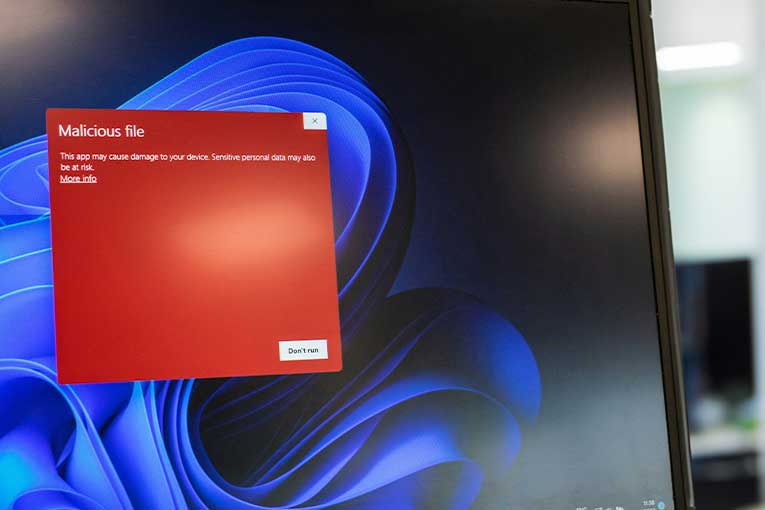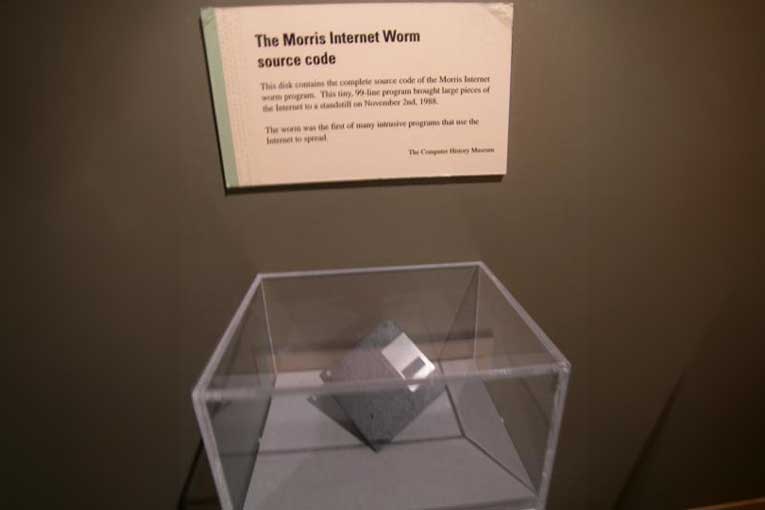Cyber Security News Aggregator
.Cyber Tzar
provide acyber security risk management
platform; including automated penetration tests and risk assesments culminating in a "cyber risk score" out of 1,000, just like a credit score.What is a Computer Worm?
published on 2024-09-01 07:00:00 UTC by Simon BurgeContent:
Our reliance on computers and the internet is in nearly every aspect of life, and the threat posed by computer worms looms large.
Unlike other types of malware, such as viruses or trojans, worms possess a unique capability to self-replicate and propagate autonomously across networks without requiring a host file or user intervention.
Understanding the anatomy of computer worms is essential in grasping their potential impact.
These malicious programs exploit vulnerabilities in operating systems, network protocols, or software applications, leveraging weaknesses that have not been patched or updated.
Protecting against computer worms demands a proactive approach to cybersecurity.
In this article we will cover exactly what is a computer worm, the different types and how to identify, remove and prevent computer worms.
What is a Computer Worm?

A computer worm is a type of malicious software (malware) designed to replicate itself and spread across computer networks independently.
Unlike viruses, which attach themselves to files or programs, worms operate as standalone entities capable of moving across systems and networks, exploiting vulnerabilities in operating systems, applications, or network protocols.
Once a computer worm infects a system, it can autonomously replicate and distribute copies of itself to other computers or devices on the same network.
This self-replicating behaviour enables worms to spread rapidly, potentially infecting a large number of devices within a short period.
Worms can propagate through various means, such as email attachments, malicious websites, network shares, or vulnerabilities in software that have not been patched.
The primary objective of a computer worm is often to cause disruption, steal sensitive information, or create a backdoor for attackers to access systems remotely.
Due to their ability to spread quickly and autonomously, worms are one of the main cybersecurity threats to individuals, businesses, and organisations worldwide.
What are the Different Types of Computer Worm?

Computer worms can vary in their methods of propagation, payload, and impact on infected systems. Here are some common types:
Email Worms
These worms spread through email attachments or links.
Once opened, they exploit vulnerabilities to infect the host system and replicate by sending copies of themselves to contacts in the victim’s address book.
Network Worms
These worms exploit vulnerabilities in network services or protocols to spread across interconnected devices.
They scan for vulnerable systems and use automated techniques to infect them.
File-sharing Worms
These worms target peer-to-peer (P2P) file-sharing networks.
They disguise themselves as legitimate files or software and spread through shared directories, infecting other users who download or open the infected files.
Instant Messaging Worms
These worms propagate through instant messaging platforms by sending links or files containing malicious code to contacts in the victim’s friend list.
When clicked, they infect the recipient’s system and continue spreading.
USB Worms
Also known as thumb drive worms, these worms exploit autorun features on removable storage devices like USB drives.
When plugged into an infected computer, they copy themselves onto the drive and can spread to other systems when the drive is connected.
How to Identify a Computer Worm

Identifying a computer worm requires awareness of its common behaviours and symptoms.
Here’s how to recognize if your system is infected:
Unusual Network Activity
Computer worms often cause a noticeable increase in network traffic.
You may observe a sudden slowdown in internet speed could indicate that a worm is consuming bandwidth.
Your network monitor or firewall logs may also show unusual data transfers to unfamiliar IP addresses or domains.
System Performance Issues
Worm infections can impact system performance in several ways.
You should monitor your system’s task manager for processes consuming unusually high CPU resources.
Worms may overload the system, leading to frequent freezes or crashes.
Unexpected Behaviour
Watch out for unexpected changes in your system.
Worms may install or execute files that you did not download or install.
Some worms delete or encrypt files, rendering them inaccessible.
Security Alerts
Your antivirus or security software may detect and alert you to a worm infection.
Pay attention to alerts about suspicious files or activities.
Firewall logs may show attempts by the worm to communicate with external servers.
Email and Messaging
Worms can spread through email or messaging platforms.
Be cautious of emails with unexpected attachments or links, even from known contacts.
Instant messaging platforms may receive unexpected messages containing links or files.
System Scans
Regularly conduct scans using reputable antivirus software.
Review scan reports for identified threats, including worms and other malware.
How to Remove a Computer Worm

Removing a computer worm requires a systematic approach to ensure thorough eradication from your system.
Here’s a detailed guide on how to remove a computer worm effectively:
Disconnect from the Network
Firstly, disconnect your computer from the internet and any local network to prevent the worm from spreading further or communicating with its command and control servers.
Use Antivirus Software
Initiate a comprehensive scan of your system using up-to-date antivirus software.
Allow the software to scan all files, directories, and system areas where the worm may have embedded itself.
Antivirus software is designed to detect and eliminate malicious code associated with the worm.
Quarantine or Remove Detected Files
Once the antivirus scan is complete, review the scan results.
Quarantine or delete any files identified as infected with the worm or associated malware.
Follow the prompts and recommendations provided by the antivirus software to ensure effective removal.
Use Anti-Malware Tools
Perform a secondary scan using anti-malware tools to detect and remove any remnants or additional malware that may have been missed by the initial antivirus scan.
Anti-malware tools can provide additional layers of security and help clean up any residual threats.
Manual Inspection and Cleanup
For persistent infections or complex worms, consider manual inspection and cleanup:
- Registry and Startup Items: Review and clean up registry entries and startup items that may have been modified or added by the worm.
- File System: Manually check critical system files and directories for suspicious files or changes made by the worm.
Update and Patch System
Ensure your operating system, software applications, and antivirus/anti-malware tools are updated with the latest patches and security updates.
Keeping your system updated helps protect against known vulnerabilities exploited by worms and other malware.
How to Prevent a Computer Worm

Preventing computer worms requires proactive cybersecurity measures to safeguard your system against potential vulnerabilities and malicious attacks.
Here’s a guide on how to help prevent a computer worm:
Install and Maintain Antivirus Software
Antivirus software plays a crucial role in detecting and preventing computer worms and other malware.
Choose a reputable antivirus program and ensure it is regularly updated to defend against the latest threats.
Schedule automatic scans to run at regular intervals to identify and remove any potential threats before they cause harm.
Keep Your Operating System and Software Updated
Regularly update your operating system and software applications with the latest security patches and updates.
Operating systems and software vendors release patches to address vulnerabilities that could be exploited by worms and other malware.
Enable automatic updates wherever possible to ensure you are protected against known security flaws.
Use a Firewall
Activate and configure a firewall on your computer or network to monitor incoming and outgoing traffic.
Firewalls act as a barrier between your system and potential threats from the internet, blocking unauthorised access and helping to prevent the spread of worms and other malicious software.
Exercise Caution with Email and Downloads
Be cautious when opening email attachments or downloading files from the internet, especially from unknown or suspicious sources.
Computer worms often spread through infected email attachments or malicious downloads. Verify the legitimacy of email attachments and download files only from trusted sources.
Enable Network and Browser Security Features
Utilise network and browser security features to enhance your protection against computer worms.
Enable security settings such as pop-up blockers, phishing filters, and safe browsing modes to reduce the risk of inadvertently downloading malicious content.
Educate and Train Users
Educate yourself and other users on safe computing practices and the risks associated with malware infections.
Train users to recognize phishing attempts, suspicious links, and potential signs of a computer worm infection.
Encourage the adoption of strong password practices and regular backups of important data.
Monitor System Activity
Regularly monitor your system for unusual behaviour or signs of a potential worm infection, such as unexpected network traffic, slow performance, or unauthorised access attempts.
Implement intrusion detection systems (IDS) or intrusion prevention systems (IPS) to detect and respond to suspicious activity promptly.
Famous Examples of Computer Worms

Computer worms have played a significant role in shaping the cybersecurity landscape, often gaining notoriety for their widespread impact and disruptive capabilities.
Here are some famous examples of computer worms that have left a lasting mark on the digital world:
Morris Worm (1988)
The Morris Worm, created by Robert Tappan Morris, Jr., is considered one of the first computer worms to spread extensively across the early internet.
Released in 1988, it exploited vulnerabilities in Unix systems, infecting thousands of computers and causing significant disruption.
The Morris Worm highlighted the potential dangers of networked computing and led to increased awareness of cybersecurity threats.
ILOVEYOU (2000)
The ILOVEYOU worm, also known as the Love Bug or Love Letter, spread via email and instant messaging systems in May 2000.
It enticed users to open an attachment claiming to be a love letter, but instead, it executed a malicious script that infected Windows systems, overwriting files and spreading rapidly.
The ILOVEYOU worm caused widespread damage, infecting millions of computers worldwide and highlighting the vulnerabilities of email systems to social engineering attacks.
Code Red (2001)
Code Red was a computer worm that targeted servers running Microsoft Internet Information Services (IIS) in July 2001.
Exploiting a buffer overflow vulnerability, Code Red spread quickly and launched distributed denial-of-service (DDoS) attacks on various websites, including the White House’s website.
Code Red underscored the importance of promptly applying security patches and updates to prevent widespread infections.
Conficker (2008)
Conficker, also known as Downadup or Kido, emerged in 2008 and infected millions of computers running Microsoft Windows.
It spread primarily through network vulnerabilities and USB drives, creating a botnet capable of launching cyberattacks and stealing sensitive information.
Conficker’s sophisticated propagation methods and encryption techniques made it challenging to detect and remove, posing a significant threat to global cybersecurity.
WannaCry (2017)
WannaCry ransomware leveraged EternalBlue, a vulnerability in Microsoft Windows SMB protocol, to propagate rapidly across networks worldwide in May 2017.
It encrypted files on infected computers and demanded ransom payments in Bitcoin.
WannaCry affected hundreds of thousands of systems in over 150 countries, disrupting businesses, hospitals, and government agencies.
The global impact of WannaCry underscored the importance of vulnerability management and cybersecurity readiness.
Conclusion
Hopefully you now have an understanding of exactly what is a computer worm.
Computer worms pose significant cybersecurity risks by exploiting vulnerabilities to spread malware across networks and systems.
Understanding their behaviour, implementing effective prevention strategies, and promptly responding to infections are essential for protecting against these persistent threats in today’s digital age.
https://securityjournaluk.com/what-is-a-computer-worm/
Published: 2024 09 01 07:00:00
Received: 2024 09 08 07:11:51
Feed: Security Journal UK
Source: Security Journal UK
Category: Security
Topic: Security
Views: 13
